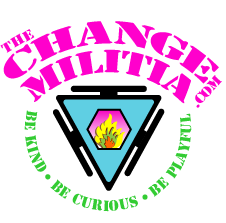Layer Twenty-Three, Week One – Sunday
- Read Week One Concepts
- Watch videos and read description for Beyond The Dots
- Do Movement – Beyond The Dots
Sunday’s Focus
Explore the nature of your reactivity and responsiveness. Feel for the fundamental differences.
Sunday’s Concepts
Last week, you explored the nature of your ingrained and patterned resistance. If you didn’t spend much time with the Focuses, go back and explore them. They will be the key to understanding your subconscious motivations and fears.
This week, you will learn ways to shift from being reactive to responsive. The fundamental difference is reactivity is a fear response instigated by your subconscious mind. Responsiveness is a conscious decision to welcome change and explore opportunities.
Responsiveness fuels opportunities. Reactivity feeds your subconscious mind.
Both are energetic exchanges. Can you feel how that happens?
Reactions move energy through your subconscious mind. You take in the incoming energy as a threat and then allow your subconscious mind to channel that energy wherever it wants. It might be out again as a reaction or you might direct it to one of your bodies or chakras to confirm and fuel the triggered fear. It might use the incoming energy to compound some held energy and upscale the reaction.
Three siblings react differently to parental criticism:
Samuel absorbs the energy and holds onto it. He is overweight and has digestive issues. He has trouble getting motivated. His primary fear response is to Freeze. Energy comes in… and stays there. Samuel is a loner, happiest in his room playing video games. He does not initiate and maintain conversations. People view him as aloof or sullen.
Samantha reacts in a different way to her parent’s jibes. She is a worrier. She tries to predict and please. Her fear response is Fix. She has acne, nervous ticks, and trouble sleeping. The energy comes in and bounces around her system, triggering one fear after another. Her energy is frenetic. She has trouble connecting deeply to others and is prone to emotional vacillations that have a limited gamut. She either feels okay or less than okay. Any time she feels better than okay, her constant worrying flares like a match and quickly extinguishes her good mood.
Samilla is the fighter. When her parents criticize her, she argues and counterpunches. Samilla is either overenergized or exhausted. She takes the incoming energy and combines it with her held fears before unleashing it. Samilla is angry, prone to outbursts. Everything feels like a battle to Samilla. She thinks she is engaging; others find her contrary and argumentative.
Monday’s Focus
How do you process criticism? How do you react? What thoughts and emotions are typical? Where do you feel it in your body?
Monday’s Concepts
Responsiveness creates momentum for growth, adaptation, and success by welcoming change.
These three siblings respond to their parental criticisms:
Jessy is a logician. He listened to what his parents said and contemplated the factuality. If he determined that the criticism was unfounded, he forgot it and went about his day. If it seemed warranted, he figured out ways to improve. Jessy became a research scientist, developed a machine to measure the energy field of DNA, and won the Nobel Prize for Science. Happily married, Jessy has a bountiful garden and is a wonderful father to his children.
Bessy is an empath. She feels her parent’s harsh words and allows them to flow through her emotional body where she absorbs the energy and uses it to feel more deeply, to enliven her. Bessy feels her parents fear and pain and their criticisms help her know them better. Bessy works with veterans suffering from PTSD. She writes books, gives lectures, and has a huge on-line presence helping people release the held trauma in their systems.
Tess used her parent’s acerbic nature to fuel her love for travel. She used the energy of their vitriolic outbursts to create momentum. She would hold onto their words and use them to propel her toward actions that helped her to move toward the things, places, and people that fascinate her. Tess produces documentaries about cultures. She finds divergent commonalities between people of different faiths.
Reactivity or response is a choice. It is a fundamental part of the personality and it is habitual.
Tuesday’s Focus
Is there someone in your life that you respond to in beneficial ways? What makes them different? What values are you attaching and how are they preferential?
Tuesday’s Concepts
When you are reactive (fearful), you judge everything by its potential threat. Pain, loss, and death are at the core of every reaction and interaction. If you posture defensively, every sight, smell, sound, touch, and energetic vibration filters through your subconscious mind before it comes in contact with your conscious mind.
When you prioritize your subconscious mind, it is in control of your personality.
Your personality becomes a parade of your fears when you are reactive. People perceive you by the resistance and defensiveness you project. Your reactions lack productivity, creativity, and innovation.
In Layer 21, Week 3, we talked about bias and predisposition. Here is a quick synopsis.
Biases are the primary components of your belief system (personality). Their purpose is to limit potential, opportunity, action, and change. Every bias reduces your ability to be present, aware, and responsive.
Every bias will have a built-in reaction cycle, a series of behaviors that follow each other habitually. Your subconscious mind is innately defensive, it is constantly looking for threats.
Once you identify a potential threat, your subconscious mind reconfigures and unleashes held fear energy to amplify the threat. It takes held energy and combines it with the current threat to make the current threat feel more threatening.
In the short-term, most fear has limited influence. Energies get destabilized, rebalance, and carry on. In the long-term, fear creates reaction cycles. Reaction cycles are the building blocks of habits and biases … which leads to imbalance, injury, and disease. Reaction cycles are how fears gain value. As fear co-opts chakras into being reactive, they prioritize threat detection instead of energy metabolization. They create a bias or a defensive predisposition. More energy goes toward worrying and less into doing … and productivity and efficiency wane. You get into the habit of worrying.
Reaction Cycle – Defensive Predisposition (patterns and habits) ➜ Amplify Threat ➜ Look for Trigger ➜ React (dump energy) ➜ Replenish Held Energy Stores ➜ Confirm and Reestablish Habitual and Familiar Defensive Predisposition.
Your personality is a compounding of your reaction cycles.
Wednesday’s Focus
Find one of your triggers and track your Reaction Cycle. How is that reaction cycle part of your personality?
Wednesday’s Concepts
Molly loved to take videos of her scientific experiments. She would post them on social media with detailed explanations of the underlying theories, her hypothesis, and results. She would get tens of thousands of views and hundreds of comments on every video. As with anything posted online, there were lovers, haters, and people who watched without liking, disliking, or commenting.
Molly, version one, would read every comment and skip the appreciative ones. She discounted the accolades and obsessed over the negative comments and dislikes. Regardless of what they said, she took it personally. If someone scolded her for putting science before God, she would research religious scientists and look for ways she could present her work so as not to offend the devout. If some troll said the video was stupid, she would take offense and retort with a curse and a condemnation.
Molly V1, exhausted herself by reacting to her critics. She gave up her social media presence but still occasionally did experiments in her basement with her cat the only audience. Molly’s reactivity led to a downward spiral of insecurity and resentment. With every reaction cycle, she reduced her ability to expand and connect with others. They found her perfectly preserved corpse several weeks after her death with a Hot Pocket® in one hand and a Diet Fanta® in the other.
Molly, version two, glanced at the comments, looking for insightful questions to answer. She skipped the trolls and allowed herself to absorb the energy of the encouragements and appreciations. Her audience continued to grow, which funded more elaborate experiments, which gained larger audiences. The History Channel offered her a weekly series, which led to an HBO special, which led to her being selected as the Head of Scientific Research for National Geographic. Molly’s responsiveness created momentum and compounding successes.
Molly V2 is incredibly vital. Beyond her scientific career, she creates edible art parties for her friends and commutes daily 16 miles to work on a bike she designed and built herself.
Thursday’s Focus
Where are you Molly V1 (from Wednesday’s Concepts) and how could you transform that into Molly V2?
Thursday’s Concepts
To Shift from being reactive to responsive, you will increase awareness and tolerate healthy discomfort.
Redirecting reactive energy requires presence, awareness, a strong Hara, and a big upwelling of Essence.
Habitual energy flows need an alternative expression, someplace new to go. Change requires that those reactive cycles transform into responsive cycles. The easiest way is to redirect them – get off one dysfunctional rollercoaster and get on another, healthier rollercoaster. The process would continue toward finding and habituating to less energy-intensive rollercoasters. Eventually, the habit will transform into a gentle ride toward improved health, increased fulfillment, and flourishing happiness.
Shifting from being reactive to responsive is akin to changing the center of your universe. Everything will have a fresh and unfamiliar perspective. You will learn to see things in alternative ways from new value-sets. Your personality will be more fluid. Fluid personalities adapt quickly to current energy potentials (opportunities). It may be hard to imagine your personality instantly changing to maximize your fulfillment, creativity, and connection. Seek to eliminate the boundaries your personality generates.
Don’t overthink. Feel for the sensations that lack fluidity and make changes to increase the effortless energy flows in each of your bodies.
The path: Find where and how you are the most reactive. Start with the macro. Is your reactivity triggered by Too Much or Not Enough? Next, move to the bodies. Then, onto the components. Find your predilections, patterns, and preferences. Where do your values and priorities constrain your personality? What is your resistance and where does it reside?
Friday’s Focus
Spend some time tracking your degree of discomfort? When are you uncomfortable and how much discomfort can you tolerate before you get reactive?
Friday’s Concepts
Let’s look at the above in a bit more detail.
Identify, allow, and accept where your reactivity has the greatest non-beneficial impact. You will be reactive in hundreds of ways, most of them habitual. Some will be mild distractions, some dysfunctions. Address the dysfunctions first. Where do you siphon off most of your vitality to feed your subconscious mind? Start making incremental changes.
Each of your bodies will collude with your biggest reactive drain. Deconstruct your reactivity and figure out how your mental, emotional, physical, environmental, energy, gravity, and ethereal bodies are complicit. Ascertain how each of your bodies configures as you blunder and glitch. One body will lead, and the others will follow. Find the leader and figure out ways to devalue it. Identify how the other bodies collude and reconfigure them. You will reconfigure them by making minor adjustments.
If you find your major reactivity leaves your body feeling numb, pick a limb and move it. Gradually increase the scope and intensity of your movements. If you find your body feels prickly or frenetic, do some big movements like squats to reset your energy flows. Incrementally remove the collusions. Allow the small adjustments to compound.
After you look at your bodies, look at the components of your reactivity. Which of the seven components is the primary imbalance? Remember, it may be the one with the most energy or the least. What can you do to create some balance?
If your major reactivity is to worry, you are focusing excessively on your worries. Defocus by actively rejuvenating. You could engage your mind, body, emotions, and energy in movements that would increase your speed, strength, flexibility, stability, and endurance. Reactivity is a habit made up of habitual movements. Change the pieces and the puzzle transforms. Zig when you want to zag. Be increasingly playful.
You might start by shifting your focus. Focused on worrying? Count to 200 by fours. Practice your cartwheels. Balance on one foot while singing Nat King Cole songs. Refocusing will help to devalue the worry. Replacing a dysfunction with a distraction is an incremental success.
Saturday’s Focus
Explore the value you place on your reactions. Where are they habitual and valueless? Where do they actually trigger fear? Is that fear factual?
Saturday’s Concepts
Resistance plays a key part in habitual reactivity. Once you figure out all the pieces to your puzzle and how you put them together, you will still need to overcome your resistance. Again, incremental changes to your resistance will give you long-term success. Ask any ultrarunner, it is much easier to climb a mountain taking small steps than long strides.
Welcome and celebrate the discomfort that accompanies growth and change. One of the major consequences of reactivity is that it moderates your vitality level. It may not feel like it while you are actively dysfunctioning but the result will always be that you stay comfortably ensconced in your typical and habitual limits.
Reactivity is like taking all your energy to design, build, and then fight off an army of murderous robots SO THAT you can spend more time lounging on your sofa.
Put less value on couch dwelling as you lower your reactivity and increase your ability to respond. Design robots that remove invasive plants while planting and watering native seeds. Take on larger projects that challenge your ability to lead, listen, and collaborate. Build hempcrete houses and teach children to yodel while running up hills. Keep your diet clean, your hedges trimmed, and your fitness optimized.
Next week, you will tackle the final part, Change the world from the inside out.
Beyond the Dots
Find a comfortable seat and make sure you have 15-20 minutes of uninterrupted time.
- Take several softening breaths, let the tension melt and your energy begin to flow.
- Settle and balance before you continue.
- Become increasingly aware of the energy above your head flowing in through your seventh chakra.
- As you feel the energy moving into and down your CPC, see if you can feel the energy coming into both sides of your Six Chakra at the same time.
- Once you feel the energy flows in the front and back of your sixth chakra in addition to your seventh, add the front and back of the fifth chakra.
- Follow the same procedure for each of your other chakras, working your way down.
- After you have made your way down to your second chakra, begin to open up your first chakra.
- As you begin to absorb energy into your first chakra, feel for the circulation of energy that happens.
- Spend as much time as you have increasing your sensitivity to the energy flows.
Why it Matters – Feeling energy flows in your body in a general way will lead to feeling your energy flows in more subtle ways. Eventually, you will be able to sense complex energy flows as they are happening.
Everyday Usability – As you begin to master this practice, your awareness of energy patterns will increase. You will begin to feel the energy patterns in others, groups, and situations.
Progression – After you feel your subtle energy flows, they will begin to become apparent in the world around you, in others, and in interactions. You will feel the variance in energy flows between actions and reactions. You will feel the precursor energy to reactions. You will be able to feel how fear moves, opportunities arise, and creative germinates.

















